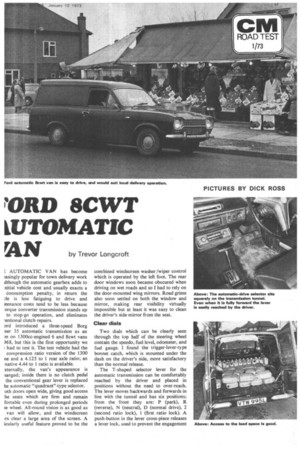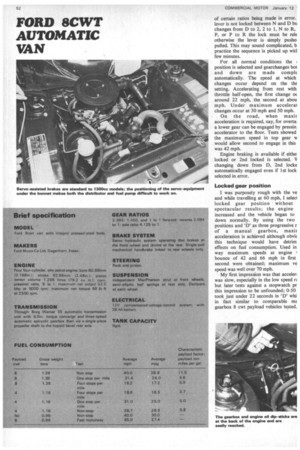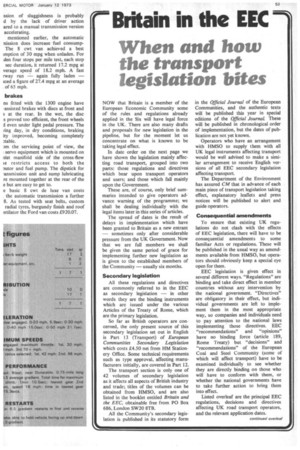'ORD 8CWT
Page 53

Page 54

Page 55

If you've noticed an error in this article please click here to report it so we can fix it.
IIITOMATIC
ANby Trevor Longcroft AUTOMATIC VAN has become :asingly popular for town delivery work dthough the automatic gearbox adds to nitial vehicle cost and usually exacts a consumption penalty, in return the z.le is less fatiguing to drive and iteriance costs tend to be less because orque converter transmission stands up to stop-go operation, and eliminates ,entional clutch repairs.
ord introduced a three-speed Borg ner 35 automatic transmission as an )n on 1300cc-engined 6 and Scwt vans ?68, but this is the first opportunity we had to test it. The test vehicle had the compression ratio version of the 1300 ne and a 4.125 to 1 rear axle ratio; an native 4.44 to 1 ratio is available.
xternally, the van's appearance is langed; inside there is no clutch pedal the conventional gear lever is replaced he automatic "quadrant"-type selector. oth doors open wide, giving good access he seats which are firm and remain fortable even during prolonged periods wheel. All-round vision is as good as van will allow, and the windscreen :rs clear a large area of the screen. A icularly useful feature proved to be the combined windscreen washer/wiper control which is operated by the left foot. The rear door windows soon became obscured when driving on wet roads and so I had to rely on the door-mounted wing mirrors. Road grime also soon settled on both the window and mirror, making rear visibility virtually impossible but at least it was easy to clean the driver's side-mirror from the seat.
Clear dials Two dials which can be clearly seen through the top half of the steering wheel contain the speedo, fuel level, odometer, and fuel gauge. I found the trigger-lever-type bonnet catch, which is mounted under the dash on the driver's side, more satisfactory than the normal release.
The T-shaped selector lever for the automatic transmission can be comfortably reached by the driver and placed in positions without the need to over-reach. The lever moves backwards and forwards in line with the tunnel and has six positions; from the front they are: P (park), R (reverse), N (neutral), D (normal drive), 2 (second ratio lock), 1 (first ratio lock). A push-button in the lever cross-piece releases a lever lock, used to prevent the engagement
of certain ratios being made in error. lever is not locked between N and D bu changes from D to 2, 2 to 1, N to R, P, or P to R the lock must be rele otherwise the lever is simply pushel pulled. This may sound complicated, b practice the sequence is picked up vvitl few minutes.
For all normal conditions the position is selected and gearchanges bot and down are made complc automatically. The speed at which changes occur depend on the thr setting. Accelerating from rest with throttle half-open, the first change oc around 22 mph, the second at abou mph. Under maximum accelerai changes occur at 30 mph and 50 mph.
On the road, when maxir acceleration is required, say, for overta a lower gear can be engaged by pressin accelerator to the floor. Tests showed the maximum speed in top gear NI• would allow second to engage in this was 42 mph.
Engine braking is available if eithei locked or 2nd locked is selected. V changing down from D, 2nd locke automatically engaged even if 1st lack selected in error.
Locked gear position I was purposely rough with the ve and while travelling at 60 mph, I seleci locked gear position without spectacular results; the engine increased and the vehicle began to down normally. By using the two positions and 'D' as three progressive r of a manual gearbox, maxir acceleration is achieved although obvit this technique would have detrim effects on fuel consumption. Used in way maximum speeds at engine , bounce of 42 and 66 mph in first second were obtained; maximum ye speed was well over 70 mph.
My first impression was that acceler: was slow, especially in the low speed ri but later tests against a stopwatch pr this impression to be unfounded; 0-50 took just under 22 seconds in 'EY whi in fact similar to comparable ma gearbox 8 cwt payload vehicles tested.
ssion of sluggishness is probably d by the lack of driver action ared to a manual transmission version accelerating.
mentioned earlier, the automatic fission does increase fuel consumpThe 8 cwt van achieved a best mption of 30 mpg when unladen. For den four stops per mile test, each stop sec duration, it returned 17.2 mpg at verage speed of 18.2 mph. A fast rway run — again fully laden — teed a figure of 27.4 mpg at an average of 65 mph.
brakes ns fitted with the 1300 engine have -assisted brakes with discs at front and s at the rear. In the wet, the disc s proved too efficient, the front wheels even under light pedal pressure. The ring day, in dry conditions, braking ity improved, becoming completely ;table.
am the servicing point of view, the servo equipment which is mounted on alet manifold side of the cross-flow ie restricts access to both the autor and fuel pump. The dipstick for unsmission unit and sump lubricating re mounted together at the rear of the e but are easy to get to.
e basic 8 cwt de luxe van costs the automatic transmission a further 8. As tested with seat belts, custom radial tyres, burgundy finish and roof ntilator the Ford van costs £920.07.








































































































